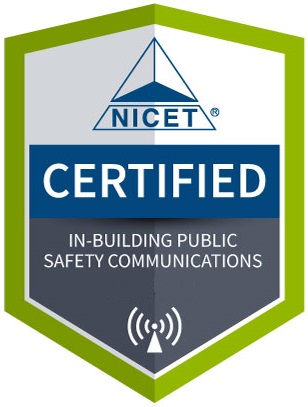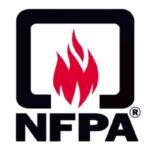Standards & Codes for Distributed Antenna Systems (DAS)
VeriDAS Technologies specializes in engineering & designing Emergency Responder Radio Coverage Systems (ERRCS) that significantly and consistently boost INDOOR RF signal levels for public safety radio systems inside large industrial, commercial or public-use buildings, facilities and campuses (including parking structures and underground areas).
We engineer, design, install and certify Public Safety Distributed Antenna Systems (DAS) to comply with FCC, NICET, NFPA & IFC standards and codes for First Responder Emergency Responder Radio Coverage Systems (ERRCS) - a requirement for all NEW buildings (including additions).
VeriDAS engineers, designs, installs, certifies and inspects Emergency Responder Radio Coverage Systems (ERRCS). Below is an example of a 2018 version of International Fire Code (IFC) for Emergency Responder Radio Coverage. Each jurisdiction enforces a different version or set of building and fire codes. VeriDAS coordinates with individual AHJs to determine their code requirements, enforcement policies and inspection criteria.
INTERNATIONAL CODE COUNCIL (ICC)
2018 International Fire Code (IFC) (Third Printing: April 2019)
Part III: Building & Equipment Design Features
Chapter 5: Fire Service Features: Chapter 5 provides requirements that apply to all buildings and occupancies and pertain to access roads, access to building openings and roofs, premises identification, key boxes, fire protection water suppliers, fire command centers, fire department access to equipment and emergency responder radio coverage in buildings. Although many safety features are part of the building design, features such as proper fire department access roads and radio coverage are necessary in case of emergency and are important tools for emergency responders for public safety and their own safety.
SECTION 510: EMERGENCY RESPONDER RADIO COVERAGE
510.1 Emergency responder radio coverage in new buildings. New buildings shall have approved radio coverage for emergency responders within the building based on the existing coverage levels of the public safety communication systems utilized by the jurisdiction, measured at the exterior of the building. This section shall not require improvement of the existing public safety communication systems.
Exceptions:
- Where approved by the building official and the fire code official, a wired communication system in accordance with Section 907.2.12.2 shall be permitted to be installed or maintained instead of an approved radio coverage system.
- Where it is determined by the fire code official that the radio coverage system is not needed.
- In facilities where emergency responder radio coverage is required and such systems, components or equipment required could have a negative impact on the normal operations of that facility, the fire code official shall have the authority to accept an automatically activated emergency responder radio coverage system.
510.2 Emergency responder radio coverage in existing buildings. Existing buildings shall be provided with approved radio coverage for emergency responders as required in Chapter 11.
510.3 Permit required. A construction permit for the installation of or modification to emergency responder radio coverage systems and related equipment is required as specified in Section 105.7.6. Maintenance performed in accordance with this code is not considered a modification and does not require a permit.
510.4 Technical requirements. Systems, components and equipment required to provide the emergency responder radio coverage system shall comply with Sections 510.4.1 through 510.4.2.8.
510.4.1 Emergency responder communication enhancement system signal strength. The building shall be considered to have acceptable emergency responder communications enhancement system coverage when signal strength measurements in 95 percent of all areas on each floor of the building meet the signal strength requirements in Sections 510.4.1.1 through 510.4.1.3.
510.4.1.1 Minimum signal strength into the building. The minimum inbound signal strength shall be sufficient to provide usable voice communications throughout the coverage area as specified by the fire code official. The inbound signal level shall be sufficient to provide not less than a Delivered Audio Quality (DAQ) of 3.0 or an equivalent Signal-to-Interference- Plus-Noise Ratio (SINR) applicable to the technology for either analog or digital signals.
510.4.1.2 Minimum signal strength out of the building. The minimum outbound signal strength shall be sufficient to provide usable voice communications throughout the coverage area as specified by the fire code official. The outbound signal level shall be sufficient to provide not less than a DAQ of 3.0 or an equivalent SINR applicable to the technology for either analog or digital signals.
510.4.1.3 System performance. Signal strength shall be sufficient to meet the requirements of the applications being utilized by public safety for emergency operations through the coverage area as specified by the fire code official in Section 510.4.2.2.
510.4.2 System design. The emergency responder radio coverage system shall be designed in accordance with Sections 510.4.2.1 through 510.4.2.8 and NFPA 1221.
510.4.2.1 Amplification systems and components. Buildings and structures that cannot support the required level of radio coverage shall be equipped with systems and components to enhance the public safety radio signals and achieve the required level of radio coverage specified in Sections 510.4.1 through 510.4.1.3. Public safety communications enhancement systems utilizing radio-frequency-emitting devices and cabling shall be approved by the fire code official. Prior to installation, all RF-emitting devices shall have the certification of the radio licensing authority and be suit- able for public safety use.
510.4.2.2 Technical criteria. The fire code official shall maintain a document providing the specific technical information and requirements for the emergency responder communications coverage system. This document shall contain, but not be limited to, the various frequencies required, the location of radio sites, the effective radiated power of radio sites, the maximum propagation delay in microseconds, the applications being used and other supporting technical information necessary for system design.
510.4.2.3 Standby power. Emergency responder radio coverage systems shall be provided with dedicated standby batteries or provided with 2-hour standby batteries and connected to the facility generator power system in accordance with Section 1203. The standby power supply shall be capable of operating the emergency responder radio coverage system at 100-percent system capacity for a duration of not less than 12 hours.
510.4.2.4 Signal booster requirements. If used, signal boosters shall meet the following requirements:
- All signal booster components shall be contained in a National Electrical Manufacturer’s Association (NEMA) 4-type waterproof cabinet.
- Battery systems used for the emergency power source shall be contained in a NEMA 3R or higher-rated cabinet.
- Equipment shall have FCC or other radio licensing authority certification and be suitable for public safety use prior to installation.
- Where a donor antenna exists, isolation shall be maintained between the donor antenna and all inside antennas to not less than 20dB greater than the system gain under all operating conditions.
- Bi-Directional Amplifiers (BDAs) used in emergency responder radio coverage systems shall have oscillation prevention circuitry.
- The installation of amplification systems or systems that operate on or provide the means to cause interference on any emergency responder radio coverage networks shall be coordinated and approved by the fire code official.
510.4.2.5 System monitoring. The emergency responder radio enhancement system shall be monitored by a listed fire alarm control unit, or where approved by the fire code official, shall sound an audible signal at a constantly attended on-site location. Automatic supervisory signals shall include the following:
- Loss of normal AC power supply.
- System battery charger(s) failure.
- Malfunction of the donor antenna(s).
- Failure of active RF-emitting device(s).
- Low-battery capacity at 70-percent reduction of operating capacity.
- Failure of critical system components.
- The communications link between the fire alarm system and the emergency responder radio enhancement system.
510.4.2.6 Additional frequencies and change of frequencies. The emergency responder radio coverage system shall be capable of modification or expansion in the event frequency changes are required by the FCC or other radio licensing authority, or additional frequencies are made available by the FCC or other radio licensing authority.
510.4.2.7 Design documents. The fire code official shall have the authority to require “as-built” design documents and specifications for emergency responder communications coverage systems. The documents shall be in a format acceptable to the fire code official.
510.4.2.8 Radio communication antenna density. Systems shall be engineered to minimize the near-far effect. Radio enhancement system designs shall include sufficient antenna density to address reduced gain conditions.
Exceptions:
- Class A narrow band signal booster devices with independent AGC/ALC circuits per channel.
- Systems where all portable devices within the same band use active power control features.
510.5 Installation requirements. The installation of the public safety radio coverage system shall be in accordance with NFPA 1221 and Sections 510.5.1 through 510.5.4.
510.5.1 Approval prior to installation. Amplification systems capable of operating on frequencies licensed to any public safety agency by the FCC or other radio licensing authority shall not be installed without prior coordination and approval of the fire code official.
510.5.2 Minimum qualifications of personnel. The mini- mum qualifications of the system designer and lead installation personnel shall include both of the following:
- A valid FCC-issued general radio operators license.
- Certification of in-building system training issued by an approved organization or approved school, or a certificate issued by the manufacturer of the equipment being installed.
These qualifications shall not be required where demonstration of adequate skills and experience satisfactory to the fire code official is provided.
510.5.3 Acceptance test procedure. Where an emergency responder radio coverage system is required, and upon completion of installation, the building owner shall have the radio system tested to verify that two-way coverage on each floor of the building is not less than 95 percent. The test procedure shall be conducted as follows:
- Each floor of the building shall be divided into a grid of 20 approximately equal test areas.
- The test shall be conducted using a calibrated portable radio of the latest brand and model used by the agency talking through the agency’s radio communications system or equipment approved by the fire code official.
- Failure of more than one test area shall result in failure of the test.
- In the event that two of the test areas fail the test, in order to be more statistically accurate, the floor shall be permitted to be divided into 40 equal test areas. Failure of not more than two nonadjacent test areas shall not result in failure of the test. If the system fails the 40-area test, the system shall be altered to meet the 95-percent coverage requirement.
- A test location approximately in the center of each test area shall be selected for the test, with the radio enabled to verify two-way communications to and from the outside of the building through the public agency’s radio communications system. Once the test location has been selected, that location shall represent the entire test area. Failure in the selected test location shall be considered to be a failure of that test area. Additional test locations shall not be permitted.
- The gain values of all amplifiers shall be measured and the test measurement results shall be kept on file with the building owner so that the measurements can be verified during annual tests. In the event that the measurement results become lost, the building owner shall be required to rerun the acceptance test to reestablish the gain values.
- As part of the installation, a spectrum analyzer or other suitable test equipment shall be utilized to ensure spurious oscillations are not being generated by the subject signal booster. This test shall be conducted at the time of installation and at subsequent annual inspections.
- Systems incorporating Class B signal-booster devices or Class B broadband fiber remote devices shall be tested using two portable radios simultaneously conducting subjective voice quality checks. One portable radio shall be positioned not greater than 10 feet (3048 mm) from the indoor antenna. The second portable radio shall be positioned at a distance that represents the farthest distance from any indoor antenna. With both portable radios simultaneously keyed up on different frequencies within the same band, subjective audio testing shall be conducted and comply with DAQ levels as specified in Sections 510.4.1.1 and 510.4.1.2.
510.5.4 FCC compliance. The emergency responder radio coverage system installation and components shall comply with all applicable federal regulations including, but not limited to, FCC 47 CFR Part 90.219.
510.6 Maintenance. The emergency responder radio coverage system shall be maintained operational at all times in accordance with Sections 510.6.1 through 510.6.4.
510.6.1 Testing and proof of compliance. The owner of the building or owner’s authorized agent shall have the emergency responder radio coverage system shall be inspected and tested annually or where structural changes occur including additions or remodels that could materially change the original field performance tests. Testing shall consist of the following:
- In-building coverage test as described in Section 510.5.3.
- Signal boosters shall be tested to verify that the gain is the same as it was upon initial installation and acceptance or set to optimize the performance of the system.
- Backup batteries and power supplies shall be tested under load of a period of 1 hour to verify that they will properly operate during an actual power outage. If within the 1-hour test period the battery exhibits symptoms of failure, the test shall be extended for additional 1-hour periods until the integrity of the battery can be determined.
- Other active components shall be checked to verify operation within the manufacturer’s specifications.
- At the conclusion of the testing, a report, which shall verify compliance with Section 510.5.3, shall be submitted to the fire code official.
510.6.2 Additional frequencies. The building owner shall modify or expand the emergency responder radio coverage system at his or her expense in the event frequency changes are required by the FCC or other radio licensing authority, or additional frequencies are made available by the FCC or other radio licensing authority. Prior approval of a public safety radio coverage system on previous frequencies does not exempt this section.
510.6.3 Nonpublic safety system. Where other nonpublic safety amplification systems installed in buildings reduce the performance or cause interference with the emergency responder communications coverage system, the nonpublic safety amplification system shall be corrected or removed.
510.6.4 Field testing. Agency personnel shall have the right to enter onto the property at any reasonable time to conduct field testing to verify the required level of radio coverage.





